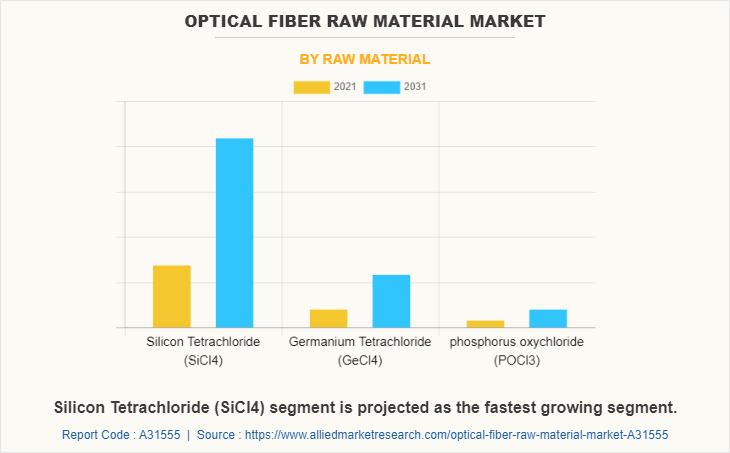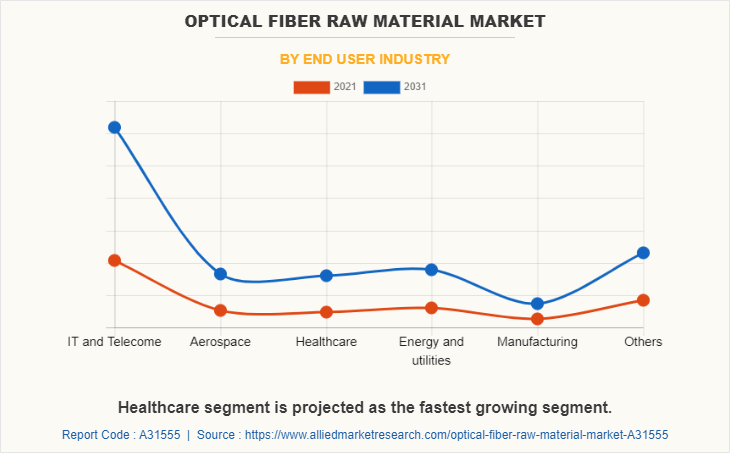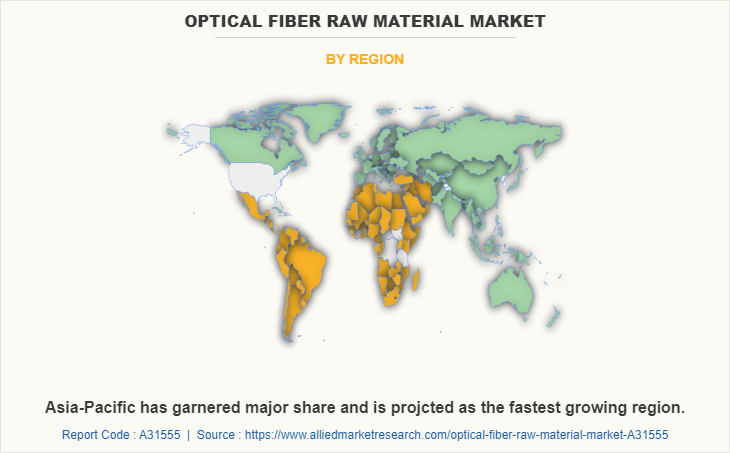Optical Fiber Raw Material Market Research, 2031
The global optical fiber raw material market was valued at $0.9 billion in 2021 and is projected to reach $2.9 billion by 2031, growing at a CAGR of 11.9% from 2022 to 2031.
Report key highlighters
- Quantitative information mentioned in the global optical fiber raw material market includes the market numbers in terms of value (USD Million) and volume (Tons) with respect to different segments, pricing analysis, annual growth rate, CAGR (2022-31), and growth analysis.
- The analysis in the report is provided on the basis of raw material and end-user industry. The study will also contain qualitative information such as the market dynamics (drivers, restraints, opportunities), Porter’s Five Force Analysis, key regulations across the region, and value chain analysis.
- A few companies, including Fujikura Ltd, Corning Inc, Sterlite Technologies Ltd, Furukawa Electric Co. Ltd, The Prysmian Group, Finisar Corporation, Sumitomo Electric Industries Ltd, hold a large proportion of the optical fiber raw material market.
- This report makes it easier for existing market players and new entrants to the optical fiber raw material business to plan their strategies and understand the dynamics of the industry, which ultimately helps them make better decisions.

Optical fiber is the medium and technology used to carry data from one source to another through a plastic or glass thread. Through optical links, information is conveyed as quick light pulses. At the receiving end of a fiber optic cable, light pulses are converted to binary values. Optical fiber provides various benefits, including higher bandwidth, reduced size, and weight, resilience to electromagnetic interference, data security, and electrical isolation, among others. These are utilized in communication applications, such as telecom, utilities, community access television (CATV), and military, as well as non-communication uses, such as sensors and fiber optic lighting.
High disposable incomes, technical advances, and quick changes in people's lifestyles have resulted in a growth in demand for more advanced and efficient electronic products, such as cell phones, computers, digital cameras, television (LCD, LED), and others. As optical fiber raw material is utilized in consumer electronics such as semiconductors and integrated circuit chips, an increase in demand for these items will have a favorable effect on the demand for optical fiber raw material.
According to the India Brand Equity Foundation, television sales in the country climbed 7.04 % between 2019 and 2021. According to the China Academy of Information and Communication, the country delivered 349 million smartphones in 2021, a 15.9% rise over the 296 million units supplied in 2020. This increase in demand and consumption of electronic devices will raise the demand for silicon tetrachloride-based semiconductors, which will have a favorable effect on the expansion of the optical fiber raw material market.
Rise in demand for silicon tetrachloride
Silicon tetrachloride is corrosive to metals in the presence of moisture, yet it is not flammable in its pure form. It is employed in the synthesis of numerous silicon-based compounds and also in chemical analysis. The chemical is also utilized in the production of semiconductors and optical fibers. As a result of their extensive use in the production of electronic goods, the demand for semiconductors has increased exponentially globally. Rapid global expansion in the manufacture of GPS, communications, and electronic gadgets is projected to have a significant impact on the rise of silicon tetrachloride.
High-purity silicon tetrachloride is a crucial raw material in the production of optical cable conductors. In recent years, the need for LTE, 4G, and 5G connections has increased exponentially, creating a demand for fiber optics. As a result, exceptional demand growth for silicon tetrachloride is anticipated to fuel the expansion of the global optical fiber raw material market in the coming years.
High installation costs of optical fiber cables coupled with a complex installation process refrain consumers from utilizing such an efficient technology, which impedes the growth of the market. Due to its high cost, many consumers turn to traditional metal wires, leading to a huge loss of data. Also, fiber optic cables are required to be coated with a material to protect them from wear and tear and transmit data without attenuation, which also adds extra costs, thereby increasing the operating cost. Therefore, high installation costs of optical fiber cables will hamper the optical fiber raw materials market.
Optical fiber raw material is in high demand due to the rapid expansion of the automobile sector and the usage of more innovative and energy-efficient technologies and vehicle components. Fiber optic cables are increasingly used in the vehicle interior and exterior lighting due to the technology's superior spatial and illumination properties. In addition, fiber optic proximity sensors can detect the closeness of target objects using light, and fiber optic cables may instantly convey signals to activate and deploy applications such as airbags or sirens and alerts, which is necessary for driver, passenger, and vehicle safety. Increasing emphasis on safety, rising demand for automobiles, and a preference for vehicles with improved safety features are some of the important drivers that are anticipated to contribute significantly to the market's revenue expansion and generate opportunities.
The optical fiber raw material market is segmented into raw material, end-user industry, and region. Depending on the raw material, the market is divided into silicon tetrachloride, germanium tetrachloride, and phosphorus oxychloride. On the basis of the end-user industry, it is categorized into IT and telecom, aerospace, healthcare, defenses, energy and utilities, manufacturing, and others. Region-wise, the market is studied across North America, Europe, Asia-Pacific, and LAMEA.
The major players operating in the global optical fiber raw material market are Fujikura Ltd, Corning Inc, Sterlite Technologies Ltd, Furukawa Electric Co. Ltd, The Prysmian Group, Finisar Corporation, Sumitomo Electric Industries Ltd, Nexans S.A., Reflex Photonics, TATA Communications.

The silicon tetrachloride segment accounted for the largest share and is the fastest-growing segment with CAGR of 12.0%. Silicon tetrachloride is a colorless, volatile liquid that is used to make high-purity silicon. It is also used to make optical fiber and fumed silica, which is used to adjust the viscosity of paint & coating, printing, adhesive, etc. As a chemical intermediate used in fractional distillation to produce polysilicon, as a raw material for semiconductors, solar photovoltaic, and consumer electronics like mobile phones and laptops, and more, silicon tetrachloride has many uses. The demand for consumer electronics is increasing, there are more solar projects being built, and the paints and coatings industry is expanding. These factors are the drivers of the demand for silicon tetrachloride.

The IT and Telecom segment accounted for the largest share. Increased deployment of fiber optics in the telecommunications industry is largely responsible for the industry's dominant market share. The telecom industry uses fiber optics for a variety of purposes, including point-to-point communication, entertainment, content delivery networks, Internet-enabled service access, vital communication, and news & infotainment. Its growth can be attributed to a growing Internet user base, low-cost services offered by service providers, the availability of inexpensive communication equipment, and an increase in the number of subscribers for various wireless and fixed-point communication devices.
The healthcare segment is the fastest-growing segment with CAGR of 13.3%, Endoscopes utilize optical fiber raw materials to support the medical imaging and illumination components of these devices. Biomedical sensors are another application of optical fiber raw material in medical devices. Biomedical sensors can be used both externally and internally and can measure a wide range of indicators within the human body, including blood temperature, body temperature, muscle displacement, heart rate, and others. Due to the non-toxic nature, compact size, and adaptability of fiber optics, they are indispensable medical instruments for numerous treatments.

During the forecast period, Asia-Pacific is expected to grow at a robust rate and account for the largest market share. The high market share can be attributed to the expanding government initiatives that support fiber optics deployment in the region. For instance, the Finance Ministry of India announced in February 2022 that the BharatNet broadband network would be operational by 2025. The BharatNet broadband network is the government's ambitious strategy to connect more than 361,000 villages across 16 states with broadband. Under this contract, optical fiber will be installed via a public-private partnership (PPP). The market for fiber optics in Asia-Pacific is primarily driven by the telecom industry. Extensive deployment of 5G base stations in China, South Korea, and Japan will contribute to the expansion of the regional market.
Key market trends
China is becoming the main region in terms of optical fiber installation. Other Asian economies, such as India and South Korea, are experiencing a significant increase in the need for optical fiber raw materials for a variety of applications. IT infrastructure's widespread deployment of optical fiber in Asia-Pacific is indicative of the material's expansion in the region.
The region's expanding industrial sector and IT infrastructure offer significant potential for optical fiber makers. Similarly, the expanding use of optical fibers in the healthcare industry is driving expansion in emerging economies such as Latin America, the Middle East, and Eastern Europe.
Developed economies such as North America, Japan, and Western Europe are spending heavily on optical fiber technologies to increase their security level and telecom infrastructure.
Key Benefits For Stakeholders
- This report provides a quantitative analysis of the market segments, current trends, estimations, and dynamics of the optical fiber raw material market analysis from 2021 to 2031 to identify the prevailing optical fiber raw material market opportunities.
- The market research is offered along with information related to key drivers, restraints, and opportunities.
- Porter's five forces analysis highlights the potency of buyers and suppliers to enable stakeholders make profit-oriented business decisions and strengthen their supplier-buyer network.
- In-depth analysis of the optical fiber raw material market segmentation assists to determine the prevailing market opportunities.
- Major countries in each region are mapped according to their revenue contribution to the global market.
- Market player positioning facilitates benchmarking and provides a clear understanding of the present position of the market players.
- The report includes the analysis of the regional as well as global optical fiber raw material market trends, key players, market segments, application areas, and market growth strategies.
Optical Fiber Raw Material Market Report Highlights
| Aspects | Details |
| Market Size By 2031 | USD 2.9 billion |
| Growth Rate | CAGR of 11.9% |
| Forecast period | 2021 - 2031 |
| Report Pages | 490 |
| By Raw Material |
|
| By End User Industry |
|
| By Region |
|
| Key Market Players | Furukawa Electric Co., Ltd., Nexans S.A., Finisar Corporation, The Prysmian Group, Sumitomo Electric Industries, Sterlite Technologies Ltd., Reflex Photonics, Tata Communications Ltd., Corning Inc., Fujikura Ltd. |
Analyst Review
According to the insights of the CXOs of leading companies, the increasing need for high-speed transmission with minimal losses has created demand space for the incorporation of optical fiber raw material. The increasing need for superior network services and networking, as well as the rising prevalence of broadband and fiber-optic Internet connections in developing nations, is one of the primary factors driving the development of fiber optics. Major optical fiber raw material makers are likely to increase their R&D efforts for the development of novel technologies and materials in the optical fiber universe, which is anticipated to stimulate the market. Similarly, the increasing awareness of the benefits of using fiber optics is driving the growth of the fiber optic raw material market. Increasing demand for the optical communication network and the need for cost-effective, energy-efficient, and highly integrated IT systems are a few more factors that contribute to the global demand for optical fiber raw materials. The adoption of optical fibers in the business market is hindered by factors such as high initial investment, labor-intensive installation of optical fiber networks on offshore terrain, and labor-intensive procedures.
The global optical fiber raw material market was valued at $0.9 billion in 2021 and is projected to reach $2.9 billion by 2031, growing at a CAGR of 11.9% from 2022 to 2031.
Fujikura Ltd, Corning Inc, Sterlite Technologies Ltd, Furukawa Electric Co. Ltd, The Prysmian Group, Finisar Corporation, Sumitomo Electric Industries Ltd, Nexans S.A., Reflex Photonics, TATA Communications are the top companies to hold the market share in Optical Fiber Raw Material.
The healthcare segment is the leading end-user industry of Optical Fiber Raw Material Market.
Asia-Pacific is the largest regional market for Optical Fiber Raw Material.
Increasing investments in optical fiber cable (OFC) network infrastructure is the upcoming trend of Optical Fiber Raw Material Market in the world.
Increasing demand for optical fiber for faster Internet connectivity and rise in demand for silicon tetrachloride are the key factors boosting the Optical Fiber Raw Material Market.
The optical fiber raw material market is segmented into raw material, end-user industry, and region. Depending on the raw material, the market is divided into silicon tetrachloride, germanium tetrachloride and phosphorus oxychloride. On the basis of end-user industry, it is categorized into IT and telecom, aerospace, healthcare, defenses, energy and utilities, manufacturing, and others.
Loading Table Of Content...


